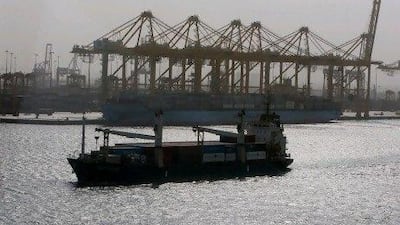Jebel Ali would have remained what it was in 1971 - a small village servicing a minor oil well on an unbroken strip of desert beach - were it not for the intuitive commercial eye of Dubai's then Ruler, Sheikh Rashid bin Saeed.
40 years of the UAE:
Flying the flag The National counts down to the historic anniversary. Learn more
The story goes that Sheikh Rashid's advisers were astounded to hear of his plans to develop a deep sea port around the tiny, desert-wrapped urban enclave. It was too far from Dubai - about 30kilometres - it had no harbour, and it would take business away from the newly opened, and still under-used, Port Rashid, by the mouth of the Creek.
The advisers - mainly merchants based round the traditional trading areas of Deira and Bur Dubai - begged him to reconsider, or at least delay. They even enlisted the support of his son, Sheikh Mohammed - the current Ruler - to help talk him out of it.
But as Sheikh Mohammed relates in his autobiography, My Vision, his father puffed on his pipe and said: "I am building this port now because there will come a time when you won't be able to afford it."
The argument was settled, and what is arguably the UAE's most valuable commercial asset was born.
Forty years later, Jebel Ali is the biggest man-made harbour in the world, and the biggest port between Singapore and Rotterdam. It dominates the Arabian Gulf as a magnet for shipping from all other regional ports.
It is first stop in the Middle East for most of the cargoes that come from Asia, Europe and the US.
About half of Dubai's exports go through Jebel Ali, which accounts for a quarter of the emirate's GDP. And about 20 per cent of total foreign investment in the UAE passes through the port and its connected industrial zone.
Tourists and travellers may arrive at Dubai or Abu Dhabi airports, and flock to the golden beaches, luxury hotels and glitzy malls, but Jebel Ali is the marketplace where the UAE meets the world.
Its five million square metres of area - equivalent to 700 rugby pitches - encompass two enormous terminals - with another being reclaimed from the sea to the north - that have supplied the raw materials for the UAE's dynamic economic growth.
It has shaped the history of the past 40 years in a more physical sense too. Located at the southern end of the emirate of Dubai, not far from the border with Abu Dhabi, Jebel Ali pulled the two biggest cities closer together. Dubai expanded southwards, giving it the elongated urban shoreline so obvious on the map today.
Some experts in urban development even believe the time will come when the two conurbations will link up in a new mega-metropolis, which they have dubbed "Abu Dubai".
Jebel Ali provided the early gravitation pull in this process, which will be reinforced when Abu Dhabi's own deep sea port and industrial zone, Port Khalifa, is fully operational just 40 km or so south of Jebel Ali.
The strategic vision came from Sheikh Rashid and was carried on by his son, Sheikh Mohammed. But the day-to-day work on the port was pushed to completion by Sultan bin Sulayem, whose family were long-standing advisers to the Al Maktoums.
Bin Sulayem had the idea of adding an industrial free zone to the port complex, which became the Jebel Ali Free Zone Authority.
It was the first instance of the "free zone" concept in the country, and has since been replicated throughout the UAE and other parts of the Gulf.
The lessons learned by bin Sulayem in the course of the dredging and land reclamation for the new port were later applied to the projects that have become Dubai's brand image round the world: the Burj Al Arab and the Palm Jumeirah. Both, like Jebel Ali, were reclaimed from the shallow waters of the Gulf and made into symbols of the Emirates.
Jebel Ali, as a hard-working asset, may lack the glamour of these later projects, but it is hard to imagine the modern UAE without the vital economic contribution it has made to the nation since 1971.

